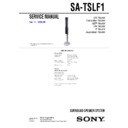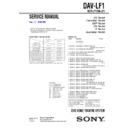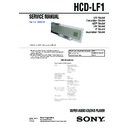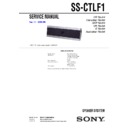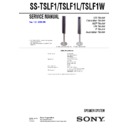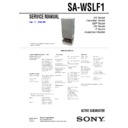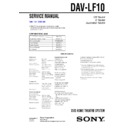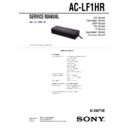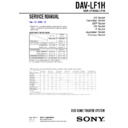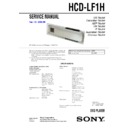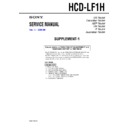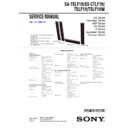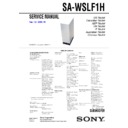Sony DAV-LF1 / SA-TSLF1 Service Manual ▷ View online
SERVICE MANUAL
Sony Corporation
Home Audio Division
Published by Sony Techno Create Corporation
Published by Sony Techno Create Corporation
US Model
Canadian Model
AEP Model
UK Model
E Model
Australian Model
SURROUND SPEAKER SYSTEM
9-879-143-02
2006I16-1
© 2006.09
© 2006.09
Ver. 1.1 2006.09
SPECIFICATIONS
SA-TSLF1
• SA-TSLF1 is surround speaker system (L)
in DAV-LF1.
Surround (L)
Speaker system
Two-way Closed box
Speaker unit
100 mm dia. cone type,
25 mm dia. balance-dome-
type tweeter
25 mm dia. balance-dome-
type tweeter
Rated impedance
4 ohms
Dimensions (approx.)
300
× 1205 × 300 mm
(w/h/d)
Mass (approx.)
6.5 kg
S
General
urround speaker (L)
Power requirements
120 V AC, 60 Hz
120 V AC, 50/60 Hz
220-240 V AC, 50/60 Hz
120 V AC, 50/60 Hz
220-240 V AC, 50/60 Hz
Power consumption
45 W (220-240 V AC)
Design and specifications are subject to change
without notice.
without notice.
North American and
Mexican models:
Taiwan model:
Other models:
Mexican models:
Taiwan model:
Other models:
2
SA-TSLF1
TABLE OF CONTENTS
1.
SERVICING NOTES
................................................
3
2.
GENERAL
...................................................................
4
3.
DISASSMEBLY
3-1.
Disassembly Flow ...........................................................
5
3-2.
Speaker Body Section .....................................................
6
3-3.
Grille Assy .......................................................................
7
3-4.
AMP Assy ........................................................................
7
3-5.
REAR PD JACK Board, REAR SP JACK Board ...........
8
3-6.
DIAT POWER Board ......................................................
9
3-7.
Speaker Section ...............................................................
9
4.
DIAGRAMS
4-1.
Block Diagram ................................................................ 12
4-2.
Printed Wiring Board – DIAT AMP Board (Side A) – ... 13
4-3.
Printed Wiring Board – DIAT AMP Board (Side B) – ... 14
4-4.
Schematic Diagram – DIAT AMP Board (1/3) – ........... 15
4-5.
Schematic Diagram – DIAT AMP Board (2/3) – ........... 16
4-6.
Schematic Diagram – DIAT AMP Board (3/3) – ........... 17
4-7.
Printed Wiring Board – DIAT POWER Board – ............ 18
4-8.
Schematic Diagram – DIAT POWER Board – ............... 19
4-9.
Printed Wiring Board – DIAT BUILT PD Section – ...... 20
4-10. Schematic Diagram – DIAT BUILT PD Section – ......... 21
5.
EXPLODED VIEWS
5-1.
Overall Section ................................................................ 26
5-2.
Stand Section ................................................................... 27
6.
ELECTRICAL PARTS LIST
.................................. 28
SAFETY CHECK-OUT
After correcting the original service problem, perform the following
safety check before releasing the set to the customer:
Check the antenna terminals, metal trim, “metallized” knobs, screws,
and all other exposed metal parts for AC leakage.
Check leakage as described below.
safety check before releasing the set to the customer:
Check the antenna terminals, metal trim, “metallized” knobs, screws,
and all other exposed metal parts for AC leakage.
Check leakage as described below.
LEAKAGE TEST
The AC leakage from any exposed metal part to earth ground and
from all exposed metal parts to any exposed metal part having a
return to chassis, must not exceed 0.5 mA (500 microamperes.).
Leakage current can be measured by any one of three methods.
from all exposed metal parts to any exposed metal part having a
return to chassis, must not exceed 0.5 mA (500 microamperes.).
Leakage current can be measured by any one of three methods.
1. A commercial leakage tester, such as the Simpson 229 or RCA
WT-540A. Follow the manufacturers’ instructions to use these
instruments.
instruments.
2. A battery-operated AC milliammeter. The Data Precision 245
digital multimeter is suitable for this job.
3. Measuring the voltage drop across a resistor by means of a
VOM or battery-operated AC voltmeter. The “limit” indication
is 0.75 V, so analog meters must have an accurate low-voltage
scale. The Simpson 250 and Sanwa SH-63Trd are examples
of a passive VOM that is suitable. Nearly all battery operated
digital multimeters that have a 2 V AC range are suitable. (See
Fig. A)
is 0.75 V, so analog meters must have an accurate low-voltage
scale. The Simpson 250 and Sanwa SH-63Trd are examples
of a passive VOM that is suitable. Nearly all battery operated
digital multimeters that have a 2 V AC range are suitable. (See
Fig. A)
Notes on chip component replacement
• Never reuse a disconnected chip component.
• Notice that the minus side of a tantalum capacitor may be
damaged by heat.
Flexible Circuit Board Repairing
• Keep the temperature of the soldering iron around 270 °C
during repairing.
• Do not touch the soldering iron on the same conductor of the
circuit board (within 3 times).
• Be careful not to apply force on the conductor when soldering
or unsoldering.
UNLEADED SOLDER
Boards requiring use of unleaded solder are printed with the lead-
free mark (LF) indicating the solder contains no lead.
(Caution: Some printed circuit boards may not come printed with
free mark (LF) indicating the solder contains no lead.
(Caution: Some printed circuit boards may not come printed with
the lead free mark due to their particular size)
: LEAD FREE MARK
Unleaded solder has the following characteristics.
• Unleaded solder melts at a temperature about 40 °C higher
than ordinary solder.
Ordinary soldering irons can be used but the iron tip has to be
applied to the solder joint for a slightly longer time.
Soldering irons using a temperature regulator should be set to
about 350
Ordinary soldering irons can be used but the iron tip has to be
applied to the solder joint for a slightly longer time.
Soldering irons using a temperature regulator should be set to
about 350
°C.
Caution: The printed pattern (copper foil) may peel away if
the heated tip is applied for too long, so be careful!
• Strong viscosity
Unleaded solder is more viscou-s (sticky, less prone to flow)
than ordinary solder so use caution not to let solder bridges
occur such as on IC pins, etc.
than ordinary solder so use caution not to let solder bridges
occur such as on IC pins, etc.
• Usable with ordinary solder
It is best to use only unleaded solder but unleaded solder may
also be added to ordinary solder.
also be added to ordinary solder.
SAFETY-RELATED COMPONENT WARNING!!
COMPONENTS IDENTIFIED BY MARK
0
OR DOTTED LINE
WITH MARK
0
ON THE SCHEMATIC DIAGRAMS AND IN
THE PARTS LIST ARE CRITICAL TO SAFE OPERATION.
REPLACE THESE COMPONENTS WITH SONY PARTS WHOSE
PART NUMBERS APPEAR AS SHOWN IN THIS MANUAL OR
IN SUPPLEMENTS PUBLISHED BY SONY.
REPLACE THESE COMPONENTS WITH SONY PARTS WHOSE
PART NUMBERS APPEAR AS SHOWN IN THIS MANUAL OR
IN SUPPLEMENTS PUBLISHED BY SONY.
ATTENTION AU COMPOSANT AYANT RAPPORT
À LA SÉCURITÉ!
LES COMPOSANTS IDENTIFIÉS PAR UNE MARQUE
0
SUR
LES DIAGRAMMES SCHÉMATIQUES ET LA LISTE DES
PIÈCES SONT CRITIQUES POUR LA SÉCURITÉ DE
FONCTIONNEMENT. NE REMPLACER CES COM- POSANTS
QUE PAR DES PIÈCES SONY DONT LES NUMÉROS SONT
DONNÉS DANS CE MANUEL OU DANS LES SUPPLÉMENTS
PUBLIÉS PAR SONY.
PIÈCES SONT CRITIQUES POUR LA SÉCURITÉ DE
FONCTIONNEMENT. NE REMPLACER CES COM- POSANTS
QUE PAR DES PIÈCES SONY DONT LES NUMÉROS SONT
DONNÉS DANS CE MANUEL OU DANS LES SUPPLÉMENTS
PUBLIÉS PAR SONY.
1.5 k
Ω
0.15
µ
F
AC
voltmeter
(0.75 V)
voltmeter
(0.75 V)
To Exposed Metal
Parts on Set
Parts on Set
Earth Ground
Fig. A.
Using an AC voltmeter to check AC leakage.
3
SA-TSLF1
SECTION 1
SERVICING NOTES
[AMP Board Input Signal Check Procedure]
Note 1:
Connect the SA-WSLF1 to the HCD-LF1. Set up the system so that the infrared signal from IR transmitter (DIR-T1) can be received by the
rear speaker (SA-TSLF1).
rear speaker (SA-TSLF1).
Note 2:
The POWER LED of this unit (SA-TSLF1) lights in red when the power of the SA-WSLF1 receiving waiting state (when data is not transmitted.)
When the power of the SA-WSLF1 is turned on and the infrared signal from IR transmitter (DIR-T1) is received by this unit (SA-TSLF1), the
POWER LED of this unit (SA-TSLF1) lights in green.
POWER LED of this unit (SA-TSLF1) lights in green.
Check procedure:
1. Connect a spectrum analyzer and an oscilloscope to the connector CN7301 pin-2 of DIAT BUILT PD board.
2. Confirm that the spectrum is displayed as shown in Fig. 1 on spectrum analyzer. Also confirm that the waveform as shown in Fig. 2
is displayed.
4.5MHz
↓
Fig. 1
Fig. 2
RECEPTOR
DIAT BUILT PD board
DIAT BUILT PD board
CN7301
2
pin
Infrared
Transmission
Transmission
Spectrum analyzer
or Oscilloscope
or Oscilloscope
IR transmitter
(DIR-T1)
Subwoofer
(SA-WSLF1)
* In the case of DIR-R3 is connected, the connector CN7301 pin-2 of
DIAT BUILT PD board is checked.
4
SA-TSLF1
SECTION 2
GENERAL
This section is extracted
from instruction manual.
from instruction manual.
Surround speaker (L)
The surround speaker (L) incorporates the IR receiver, which receives the sound from the IR
transmitter and sends it to the surround speaker (R).
Connect the surround speaker (R).
transmitter and sends it to the surround speaker (R).
Connect the surround speaker (R).
POWER
DIR-R3
IR receiver
DVD player :
HCD-LF1
HCD-LF1
DVD player : HCD-LF1
Sub woofer :
SA-WSLF1
SA-WSLF1
Sub woofer : SA-WSLF1
Front speaker :
SS-TSLF1(R)
SS-TSLF1L(L)
SS-TSLF1(R)
SS-TSLF1L(L)
Front speaker : SS-TSLF1(R)
SS-TSLF1L(L)
Center speaker :
SS-CTLF1
SS-CTLF1
Center speaker :
SS-CTLF1
SS-CTLF1
Surround speaker :
SS-TSLF1W(R)
SA-TSLF1(L)
SS-TSLF1W(R)
SA-TSLF1(L)
Surround speaker : SS-TSLF1W(R)
SA-TSLF1(L)
Remote
commander :
RM-SP320
commander :
RM-SP320
Remote commander :
RM-SP320
RM-SP320
Units required for
operation
check
Unit.
need to
checking
need to
checking
a
a
a
a
a
a
a
a
a
a
a
a
a
a
a
a
a
*
1
*
1
*
2
*
1 Only the defective unit.
*
2 Either one of them.
Units with
a
mark: The units that are required for the system operation check during repair service
However, there can be a case that some units of the system need to not be brought into repair shop depending on the unit. that became defective.
• The units that are required for the system operation check during repair service

